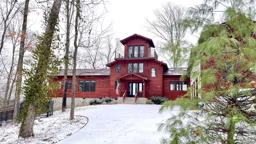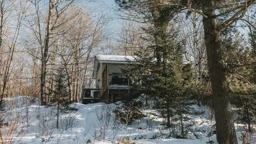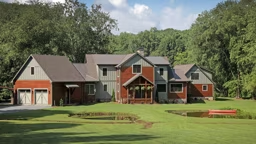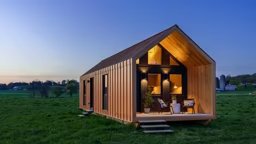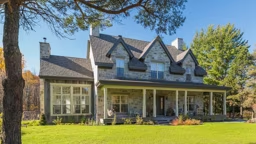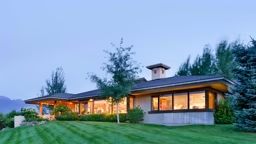Getting Creative
Given the small size of the cabin, the Rigerts and David gave special attention to the interior design and fixtures to pack the most punch. Inspiration came from fly-fishing trips to Montana, where Donna and Michael fell in love with the western architectural style including open storage, wooden beams and large windows. David says, “Now there isn’t a window in the place where you can’t see water, and from the sunroom you can see two lakes!”
Highlighting the window views are big, bulky headers as part of an ongoing wood theme. But the Rigerts didn’t want a cabin filled only with knotty pine. “We kept seeking out sources for different woods,” says Michael. The space features two-toned reclaimed heart pine, redwood from California wine barrels and reclaimed Douglas fir from the Duluth Timber Company. Most of the materials were hand scraped, sanded and oiled on site. “At times there were 7 inches of shavings everywhere,” says Michael.
Donna added personalization to the cabin by searching for detail items. These include whimsical pewter rock and leaf-themed drawer pulls and her biggest find, the hammered metal light fixtures with the name “Camp Nokomis” cut into them – a nod to the camp that used to be on the property. “When the light is on, it illuminates the lettering,” says Donna, who believes the time was well spent to find the right lighting for the small space.
Keeping it Simple
The Rigerts make good (and often) use of their little spot on the two lakes. The entire family enjoys the changes the seasons bring and engage in all manner of sports from ice fishing to water-skiing to just being “cabin bodies” reading and making great meals.
But they talk most fondly of the simplicity of a cabin that they can close up in 10 minutes and the peace it gives to their busy lives. Michael describes it as bookends. One end is his life as a father of three, a husband, and an asset manager in a highly regulated and legal environment representing his responsible Monday through Friday world. “That’s one bookend,” says Michael. “And the cabin represents my other bookend that balances all that stress and makes for peaceful, easy living.”
Lucie Amundsen lives in a little house on the shores of Lake Superior.
Given the small size of the cabin, the Rigerts and David gave special attention to the interior design and fixtures to pack the most punch. Inspiration came from fly-fishing trips to Montana, where Donna and Michael fell in love with the western architectural style including open storage, wooden beams and large windows. David says, “Now there isn’t a window in the place where you can’t see water, and from the sunroom you can see two lakes!”
Highlighting the window views are big, bulky headers as part of an ongoing wood theme. But the Rigerts didn’t want a cabin filled only with knotty pine. “We kept seeking out sources for different woods,” says Michael. The space features two-toned reclaimed heart pine, redwood from California wine barrels and reclaimed Douglas fir from the Duluth Timber Company. Most of the materials were hand scraped, sanded and oiled on site. “At times there were 7 inches of shavings everywhere,” says Michael.
Donna added personalization to the cabin by searching for detail items. These include whimsical pewter rock and leaf-themed drawer pulls and her biggest find, the hammered metal light fixtures with the name “Camp Nokomis” cut into them – a nod to the camp that used to be on the property. “When the light is on, it illuminates the lettering,” says Donna, who believes the time was well spent to find the right lighting for the small space.
Keeping it Simple
The Rigerts make good (and often) use of their little spot on the two lakes. The entire family enjoys the changes the seasons bring and engage in all manner of sports from ice fishing to water-skiing to just being “cabin bodies” reading and making great meals.
But they talk most fondly of the simplicity of a cabin that they can close up in 10 minutes and the peace it gives to their busy lives. Michael describes it as bookends. One end is his life as a father of three, a husband, and an asset manager in a highly regulated and legal environment representing his responsible Monday through Friday world. “That’s one bookend,” says Michael. “And the cabin represents my other bookend that balances all that stress and makes for peaceful, easy living.”
Lucie Amundsen lives in a little house on the shores of Lake Superior.
A Gem Beneath
But what David found when he took off the exterior caused Michael and Donna to pause. The foundation was in perfect condition and the structure was carefully engineered with premium Douglas fir framing. “According to David, we couldn’t even buy this quality of wood today,” says Michael.
However, Michael and Donna didn’t change their plans overnight. It was a process of thinking through what they wanted out of the place. With their three children nearly all out of the house, the couple reevaluated their needs.
“We started talking about what we really needed for us – how we were going to use the space 90 percent of the time – and mapped that out,” Michael says.
That’s when David really started selling the project. He sent Mike some sketches of his renovation ideas, and after some time got the call. “If you can make it look like this, then why not make it a little nicer and we’ll just forget the new house,” Michael told McNutt.
“Then the fun began,” says David, who was thrilled to preserve a piece of the camp’s history and make a special “not-so-big” cabin.
Thinking About the Box
The first hurdle was ensuring their adult children felt welcome. “We ended up building a log garage with a bunk house to handle the 10 percent of the time when we needed more guest room,” says Michael. Also the original half-basement in the cabin was dug out to accommodate a bedroom with a full bath – and a place to stash all the cabin’s mechanicals. To avoid soaking up square footage with a staircase, the lower level is only accessible via a separate outdoor entrance, which adds a layer of privacy for the Rigerts.
Next came the exterior aesthetics. Adding an impressive wrap-around porch onto the cabin’s front accomplished the couple’s goal of a strong, inviting entrance. “It’s like having a little dog that no one takes seriously,” jokes Michael. “The porch gave it that really big bark it needed.”
Another creative space addition was extending out the back of the cabin with a glassed, cathedral sun porch. Because the porch is over a low spot in the lot, it is stilt-supported, avoiding any foundation work.
“What I like about these additions are the interesting angles they added to the cabin. They broke up that symmetrical box, but you can still see the old structure within,” says Michael.
But what David found when he took off the exterior caused Michael and Donna to pause. The foundation was in perfect condition and the structure was carefully engineered with premium Douglas fir framing. “According to David, we couldn’t even buy this quality of wood today,” says Michael.
However, Michael and Donna didn’t change their plans overnight. It was a process of thinking through what they wanted out of the place. With their three children nearly all out of the house, the couple reevaluated their needs.
“We started talking about what we really needed for us – how we were going to use the space 90 percent of the time – and mapped that out,” Michael says.
That’s when David really started selling the project. He sent Mike some sketches of his renovation ideas, and after some time got the call. “If you can make it look like this, then why not make it a little nicer and we’ll just forget the new house,” Michael told McNutt.
“Then the fun began,” says David, who was thrilled to preserve a piece of the camp’s history and make a special “not-so-big” cabin.
Thinking About the Box
The first hurdle was ensuring their adult children felt welcome. “We ended up building a log garage with a bunk house to handle the 10 percent of the time when we needed more guest room,” says Michael. Also the original half-basement in the cabin was dug out to accommodate a bedroom with a full bath – and a place to stash all the cabin’s mechanicals. To avoid soaking up square footage with a staircase, the lower level is only accessible via a separate outdoor entrance, which adds a layer of privacy for the Rigerts.
Next came the exterior aesthetics. Adding an impressive wrap-around porch onto the cabin’s front accomplished the couple’s goal of a strong, inviting entrance. “It’s like having a little dog that no one takes seriously,” jokes Michael. “The porch gave it that really big bark it needed.”
Another creative space addition was extending out the back of the cabin with a glassed, cathedral sun porch. Because the porch is over a low spot in the lot, it is stilt-supported, avoiding any foundation work.
“What I like about these additions are the interesting angles they added to the cabin. They broke up that symmetrical box, but you can still see the old structure within,” says Michael.
This is not the vacation place Michael and Donna Rigert expected. But how they got here is an interesting tale of a passionate builder with vision, second looks and a willingness to take a chance.
Michael originally bought the lot because of its ideal location for his sportsman lifestyle. The wooded spit of land between two northern Wisconsin lakes had been through many incarnations over the years, including a private club, a hunting lodge and most recently – a girls’ camp.
Michael is quick to say he definitely did not buy the property for its last standing building – the camp’s old office – and planned for it to soon meet a wrecking ball to clear the way for a new, modern cabin for himself and Donna.
The “Just Tear It Down” Campaign
“We went to see it and my summary comment was, ‘The next time I come up here this needs to be gone,’” says Michael. The rectangular structure was 1,000 square feet with redstained half log exterior, tiny single pane windows and an office-grade interior suitable for its large file cabinets. “The thought of us living there was just stupid nuts,” says Michael.
When the Rigerts’ contractor, David McNutt, floated the idea of renovating the little 1950s era cabin, he admits it was not well received. “Actually, I had to beg them not to knock it down,” confesses David, who suggested the couple use it as a guest cottage or even a temporary place while their vacation home was being built. Michael and Donna remained unconvinced, but held back the wrecking ball for the time being so David could “peel back” the structure to see what lay underneath.
This began what Michael calls the “barroom chatter” among his and Donna’s well-meaning friends. “Mike and Donna aren’t really going to really renovate that crappy little camp, are they?” repeats Michael with a laugh. He knows their friends only had his and Donna’s best interests at heart during what he called the “just tear it down” campaign. But the Rigerts’ thinking was about to change.
Michael originally bought the lot because of its ideal location for his sportsman lifestyle. The wooded spit of land between two northern Wisconsin lakes had been through many incarnations over the years, including a private club, a hunting lodge and most recently – a girls’ camp.
Michael is quick to say he definitely did not buy the property for its last standing building – the camp’s old office – and planned for it to soon meet a wrecking ball to clear the way for a new, modern cabin for himself and Donna.
The “Just Tear It Down” Campaign
“We went to see it and my summary comment was, ‘The next time I come up here this needs to be gone,’” says Michael. The rectangular structure was 1,000 square feet with redstained half log exterior, tiny single pane windows and an office-grade interior suitable for its large file cabinets. “The thought of us living there was just stupid nuts,” says Michael.
When the Rigerts’ contractor, David McNutt, floated the idea of renovating the little 1950s era cabin, he admits it was not well received. “Actually, I had to beg them not to knock it down,” confesses David, who suggested the couple use it as a guest cottage or even a temporary place while their vacation home was being built. Michael and Donna remained unconvinced, but held back the wrecking ball for the time being so David could “peel back” the structure to see what lay underneath.
This began what Michael calls the “barroom chatter” among his and Donna’s well-meaning friends. “Mike and Donna aren’t really going to really renovate that crappy little camp, are they?” repeats Michael with a laugh. He knows their friends only had his and Donna’s best interests at heart during what he called the “just tear it down” campaign. But the Rigerts’ thinking was about to change.










